The Booking Calendar assists you to easily handle exclusive placements. An exclusive placement blocks other ad types, it’s important to check thoroughly if a booking is possible to prevent double bookings. With the help of the Booking Calendar, booked, offered, and available exclusive placements are visualized to give you a better overview of what is available or not.
Here you find how to use the 4.9 Booking Calendar.
In order to use the Booking Calendar, you need to configure a remote site setting. This setting allows the Booking Calendar to load data records.

Please navigate to remote site settings and enter the url from the Booking Calendar Wizard:
After creating this remote site setting the warning message should not appear anymore.
The Booking Calendar can only show Ad Prices and compare them with offered or booked Campaign Items, that are marked as "exclusive".

The following fields are used by the Booking Calendar:
Attention:
|
Here you can see which smaller units on your AdSpec are converted and shown in the booking calendar if the following time columns are selected:
| time columns → / max AppUnit | day | week | month | quarter | year |
|---|---|---|---|---|---|
| day | converted | converted | converted | converted | converted |
| week | - | converted | - | - | - |
| month | - | - | converted | converted | converted |
| quarter | - | - | - | converted | converted |
| year | - | - | - | - | converted |
In order to use the Booking Calendar, you need to configure remote site settings and create some templates.
Please navigate to the Booking Calendar Wizard:
The Booking Calendar Settings helps you to manage your templates. Templates are used to define which filters and fields a user can see.
Note: If you run the Booking Calendar the first time, you will see a warning message. Please copy the site url and create a remote site setting:
In order to use the Booking Calendar, you need to configure a template. Optionally you can use the ADvendio default templates or modify those.
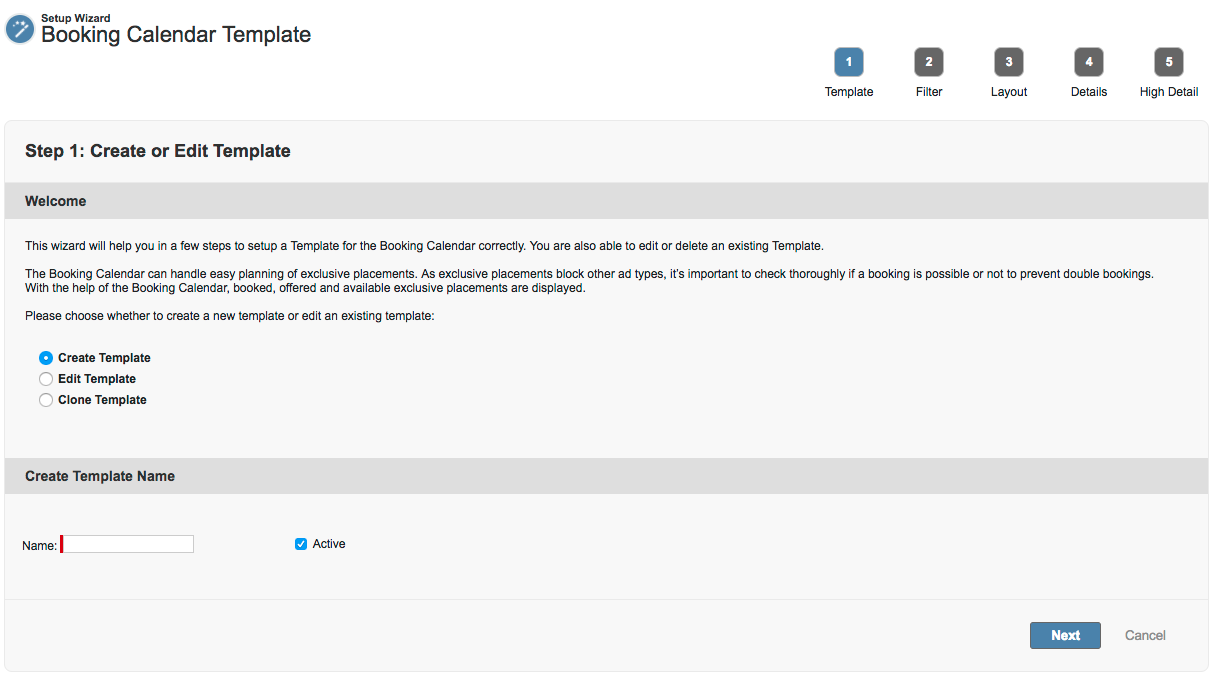
Please navigate to the Booking Calendar Wizard and create a new template:
If you have defined a name for the template, you are able to define filter fields, pre-fill filters, define layout columns and detailed information (campaign item data).
Filters allow you to search for specific sites, placements or ad types if you defined those filters. You are able to define various filters like billing category or price lists. The system has automatically defined filters that are used most frequently.

You can add filters from different objects (any linked objects, start is Campaign Item) like you would add fields to a formula field:
All fields are automatically added to the section below.
Filters allow you to search for specific sites, placements or ad types if you define those filters. You are able to predefine filters by selecting a template.

You are able to predefine filters while selecting a template that filters the results of the Booking Calendar:
Standard Fields
Custom Filters
If you have configured all settings you can go to the next step:
Note: If the time frame is too large, the time columns automatically switches to weeks, because the Booking Calendar can not display too much information. Please use filters always to display the results of records that you need.
Here you can program more advanced filters for your Booking Calendar templates.
As you need an enhanced technical knowledge on how to write queries please ask your ADvendio consultant for more information if you consider using this feature. Please keep in mind that the OR operator should not be used. |
To enable the feature you can just click the checkbox on the upper right corner in the relevant template.
After hitting the checkbox you will see two fields in the layout where you can write your query for Ad Prices and Campaign Items.

The Query for the Ad Price should be starting with an AND and the query for the Campaign Item does not need an operator to start.
Here are two examples:
The columns of the Booking Calendar can be defined to display the information that is necessary. The system has automatically defined columns that are used most frequently.

You are able to define columns (any linked objects, start as Campaign Item) like you would add fields to a formula field:
Here is your result for the example above:

If you have configured all settings you can go to the next step:
The detailed information (campaign item data) of the Booking Calendar can be defined to display the information that is necessary. The system has automatically defined columns that are used most frequently.
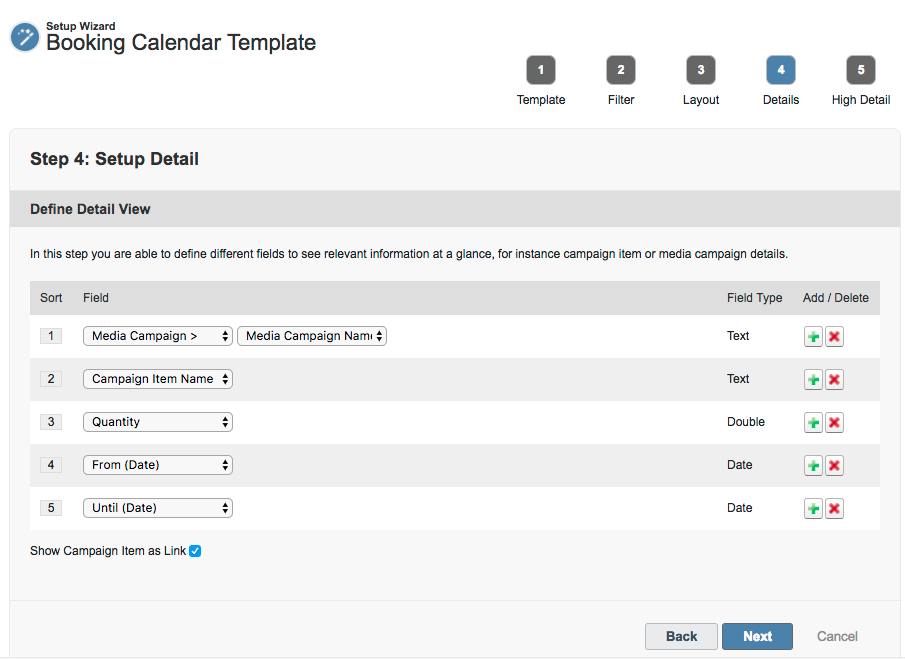
You are able to define columns (any linked objects, start is Campaign Item) like you would add fields to a formula field:
Here the result info page for the example above (clicking on the little ![]() Button):
Button):

In this step you are able to define different fields you will see when choosing "high" in the filter selection directly in the cell as opposed to step 4 when you click on the little ![]() Button.
Button.

Please choose the for you relevant information to see at a glance, for instance, campaign item or media campaign details.
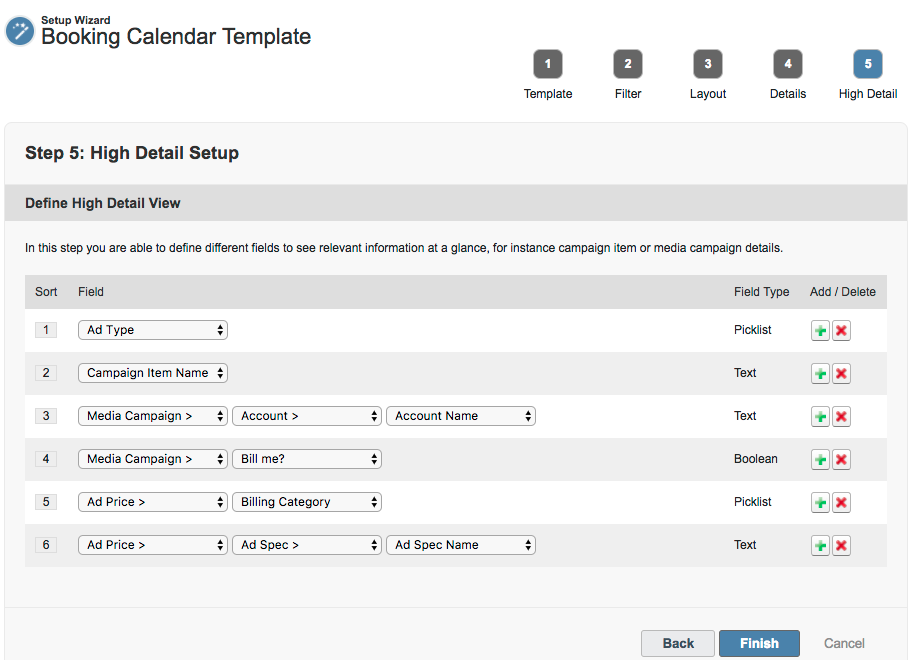
The result can look like this:

If you have configured all settings, you can go to the next step: Click the button Finish.
If you want to edit an existing template or delete a template that is not longer used, you can also use the Booking Calendar Wizard.
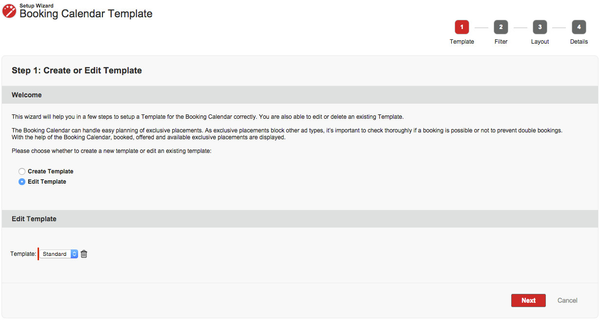
Please navigate to the Booking Calendar Wizard and edit an existing template:
You can now select an existing template and edit it or delete that template.
Templates can be activated or deactivated. A deactivated template still exists, but it will be hidden in the Booking Calendar.
To deactivate or activate an existing Template go to the Booking Calendar Settings. Click on "Edit Template" and select the Template of your choice. You can then use the Active Checkbox to activate or deactivate the Template. Afterwards click on Next to save your changes to the Template, you can then close the wizard or further adjust the template, while going through the steps.
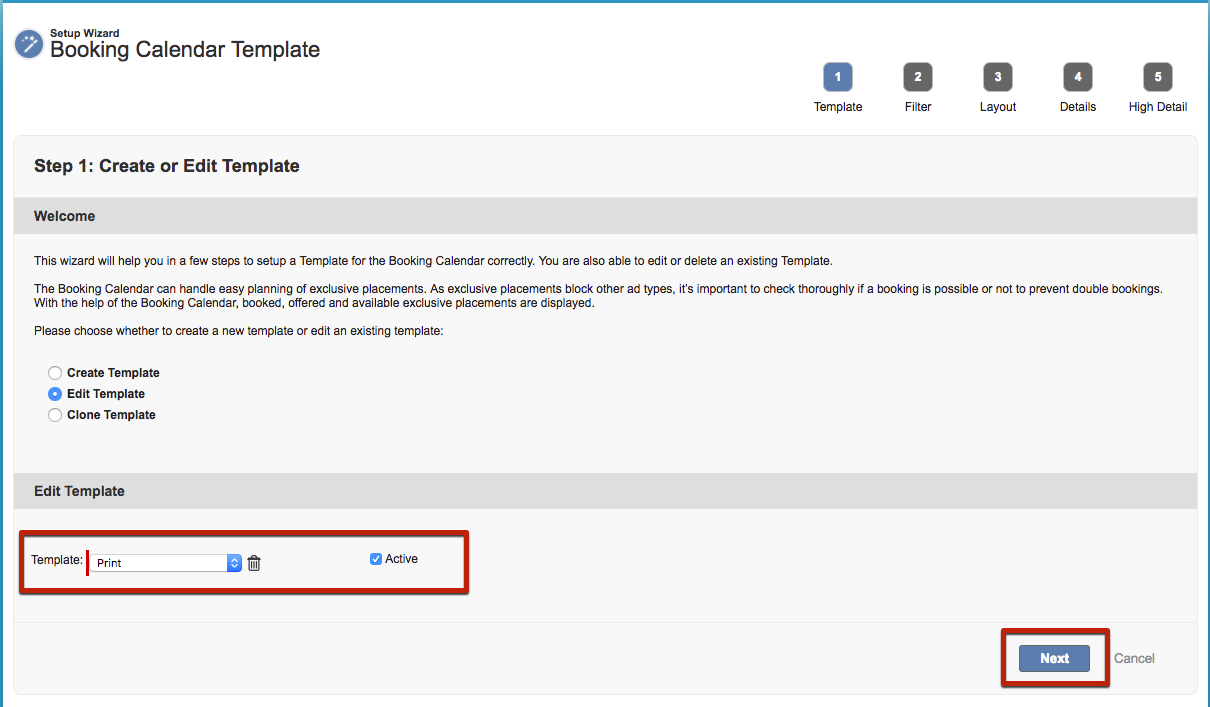
You need to click the Next button in order to save the activation or deactivation of the template, else the changes will be set back. |
In the first step in the Booking Calendar Settings select Clone.
The next 4 steps are analog to the ones described above:

With the help of the Booking Calendar, booked and offered and available exclusive placements are displayed in different colors and define some other default settings. Navigate to Setup - Custom Settings and click on Manage and Edit the ADvendio Settings:
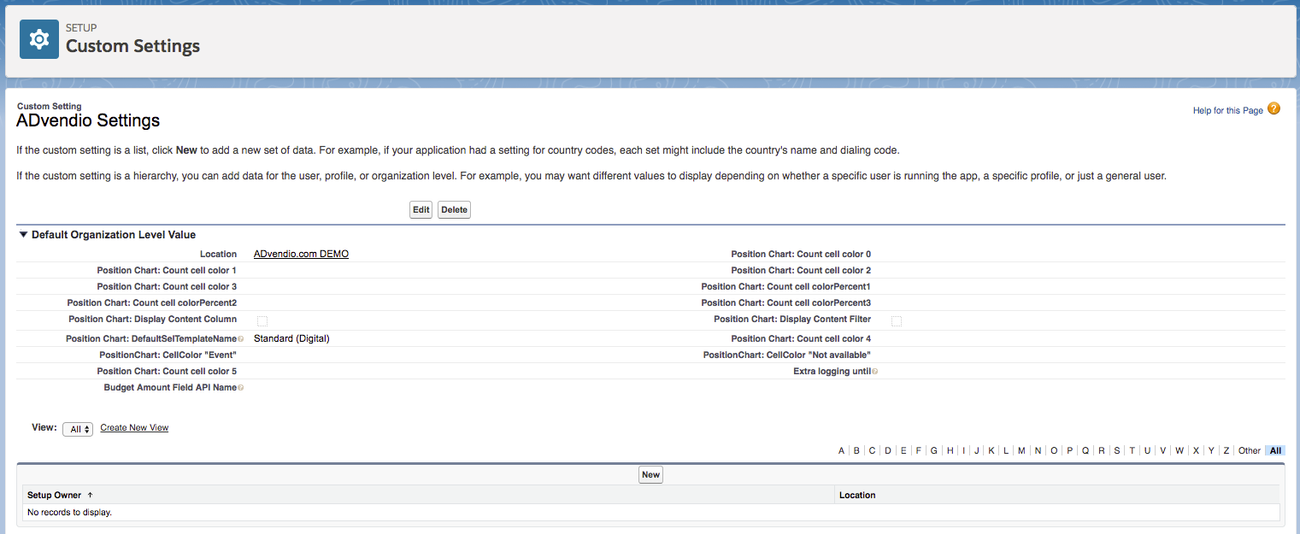

The system administrator is able to overwrite the standard color scheme and use custom colors. Just go to setup and enter HTML Color Code for the color you wish to use:
Position Chart: Count cell color 0: Position is completely available, booked + offered items = 0 Default Color: #5CFC85, dark green)
Position Chart: Count cell color 1: At least one offered item and no booked item, offered > 0 AND booked = 0 (Default Color: #CBFFC2, light green)
Position Chart: Count cell color 2: At least one booked item, but still at least 1 available, booked > 0 AND booked < maxApp (Default Color: #FFFB45, yellow)
Position Chart: Count cell color 3: The number of booked and offered items together is higher than the availability, offered + booked >= maxApp AND booked < maxApp (Default Color: #FCBF41, orange)
Position Chart: Count cell color 4: The position is fully booked, there is nothing left available, booked = maxApp (Default Color: #FF0018, red)
Probability, 100% = booked, <100% und >0% = offered Warning: the default color for fully booked and overbooked positions is the same RED, please define a custom color to avoid technical issues! |
If you like to have some kind of access control which limits users from seeing each other's Media Campaigns but the availability is still accounted for in the Booking Calendar - here is how to do it:
Just set the Media Campaign object as private (Setup - Sharing Settings). This way, all users will see the same view using the Booking Calendar (i.e., what inventory is available, booked, offered) because it does not use the Salesforce sharing model (means, sharing only private is ignored). The detail view shows the same behavior: every field is displayed with the information. So make sure to display only data that is not private to other users (like from date, until date, owner of this media campaign and stuff like that). In the case, you click on a link to a campaign you will get an error message showing "insufficient rights" if not owned by the active user.
If a template has been created, the Booking Calendar can be used if your inventory is prepared (see below).
Please navigate to the Booking Calendar:
| The Booking Calendar can only show Ad Prices and compare them with offered or booked Campaign Items if they are marked as "exclusive". To prepare your system please read the following instructions above, prepare your inventory! |